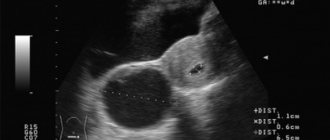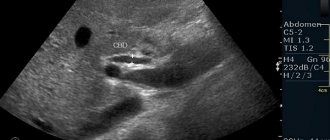Why is a smear taken?
A flora smear during pregnancy allows you to determine the state of the vaginal microflora and the possible presence of diseases.
Such a study is carried out three times during the entire period of the doctor’s control - during initial registration at the antenatal clinic, at 30 and at 36-37 weeks. A smear can be taken more often if a woman complains or if tests are unsatisfactory.
When checking the flora, the presence of leukocytes, harmful and beneficial microorganisms and their quantity are revealed.
Normally, the smear should contain lactobacilli, which prevent the penetration of pathogenic organisms into the vagina and genitals through the cervix. They maintain the acidity of the environment, which decreases when they die and becomes more susceptible to infection.
During pregnancy, the vaginal microflora changes slightly. This occurs under the influence of hormonal levels - female sex hormones constantly increase during this period.
Immunity decreases - this is necessary to prevent spontaneous miscarriage. With each week of pregnancy, an increasing number of lactobacilli can be detected in the smear - such increased protection is necessary to prevent infection of the baby through the cervix.
Assessment of a pregnant woman’s condition based on various criteria
New sensations after sexual intercourse, delay, pharmacy test, two strips, what to do?
Nothing unusual. The normal situation in the life of a woman who has become sexually active begins with questions on forums like “can a smear determine pregnancy or not?” No matter how much you put it off, the time has come to get ready to see your “favorite doctor,” climb into the hated chair and undergo a full gynecological examination. Many women do not like the very fact of visiting an antenatal clinic. You need to submit material for laboratory tests - a vaginal smear, blood, urine, and also get in line for an ultrasound. Doctors' offices and laboratories take up a lot of time and do not bring the most positive emotions, even if the future baby is so desirable. But does a smear detect pregnancy, like streaky tests? He has a different goal, and analysis alone is not enough.
An experienced gynecologist can use subtle signs to determine not only the “interesting position”, but also the duration of pregnancy in most women. They have their own methods, even if the patient came without a proven test strip and an exact indication of the day of delay.
The doctor has suggested methods for detecting early pregnancy. You shouldn’t ask him, “Is it possible to determine pregnancy by smears?” You will have to take all the tests, even if they monitor the microflora of the vagina, and not the fact of fertilization of the egg.
Each specialist has a whole set of probable and accurate signs of conception in his arsenal, for example:
- without a smear, he will be able to judge conception by palpating the uterus;
- the presence of sexually transmitted diseases will be determined by the soreness of a smear from the urethra;
- The shape of the cervix will tell you whether there has been childbirth or this is your first pregnancy.
It is difficult to determine pregnancy from smears alone, but when a sample is taken, there is access to visual signs of conception. Pregnancy is also a diagnosis, and before an ultrasound and a blood test for hCG, it is made in advance.
Attention: Further the fetus will develop, by its heartbeat doctors have the opportunity to monitor that the fetus does not freeze, tests will show the level of hemoglobin in the blood of the pregnant woman in order to eat properly. A smear will help determine whether the microflora is normal.
Therefore, it is not so important for the doctor whether the pregnant woman has decided to get rid of the embryo or will patiently follow all the instructions to maintain the pregnancy. The specialist must fulfill his medical duties by prescribing tests to monitor changes in the female body. There is no way to do without this.
Why is research needed?
This test must be taken by all expectant mothers - timely testing of the body will prevent the development of a hidden infection.
Regular flora smear testing will protect against the following factors:
- intrauterine infection;
- infection of the child during passage through the birth canal;
- spontaneous abortion;
- premature birth;
- complications of labor.
If the nature of the discharge changes and itching and burning appear in the vagina, you must take a smear to check for infections and consult a doctor with the results. A similar procedure should be carried out if infection is possible.
Normal indicators
Decoding the optimal smear indicators is represented by the following values:
Vaginal mucosa:
- leukocytes are normally 0-15 units;
- mucus is present in moderate quantities;
- yeast may be present in small quantities.
Uterine cervix:
- leukocytes - 0-30 units;
- there is no possibility to determine microflora;
- the presence of a moderate amount of mucus;
- yeast-like fungi are completely absent.
Urethra:
- leukocytes - 5-10 units;
- microflora is not determined;
- mucus is completely absent;
- yeast is also not detected.
In all localizations, the values of epithelial tissue range from 5 to 10 units. Gonococci and Trichomonas should be absent in all cases.
Possible deviations
The main reason for a bad smear is the presence of infections in the vagina. No less common is deviation of the analysis from the norm in inflammatory diseases. Both of these pathologies require immediate treatment.
Most often during pregnancy, yeast-like fungi Candida appear. They can be present in the body constantly and increase in quantity with any changes in the woman’s condition.
This disease is most often called thrush. In this case, a pregnant woman often feels severe itching of the external genitalia, a burning sensation in the vagina, the appearance of a cheesy discharge, and when diagnosed, a bad smear is determined. Thrush can be detected at any stage of pregnancy.
There are other infections detected by a smear on the flora:
- staphylococcus;
- streptococcus;
- enterobacteria;
- gardnerella;
- Trichomonas;
- gonnokoki;
- herpes.
With additional examination of the smear for infection, ureaplasma, mycoplasma and chlamydia can be detected. Their presence requires immediate treatment.
Pregnant women are allowed to use vaginal suppositories, therapy with which continues for 5-14 days. If there is no effect, the course is extended.
In the first trimester, any treatment is prescribed by a doctor with great caution, and if possible, it is postponed to a later date.
There may be other abnormalities in the flora smear. An increased content of leukocytes indicates the course of the inflammatory process in the genital organs.
To eliminate this disease, the doctor prescribes anti-inflammatory drugs to the woman. Treatment of such chronic diseases is difficult due to the limited use of medications, so full therapy can only be completed after childbirth.
During the course of such diseases, the doctor may constantly determine a bad smear with a high content of leukocytes.
Sexual infections
During pregnancy, smears for infections - sexually transmitted diseases - should be taken without fail. Diseases such as ureplasmosis, herpes, chlamydia, toxoplasmosis, cytomegalovirus do not always make themselves felt, but this does not mean that they do not pose a danger.
Hidden infections can be detected using PCR diagnostics, culture and the Gram smear staining method. Another popular method is the enzyme immunoassay of blood serum.
Smear collection
A smear test for flora in pregnant women is carried out on a gynecological chair. A vaginal speculum is used for this. Biomaterial is collected from the urethra, vagina and cervix. These places are most susceptible to possible infection.
The material obtained by taking a smear is placed on a glass slide and then examined in the laboratory under a microscope. Each clinic can use its own method for this, so it is recommended to repeat the test in the same place.
Purpose of the analysis
In order to prevent and prevent the development of dangerous diseases, cytology of a smear from the cervical canal is done for every woman. This analysis allows us to identify abnormalities in the cellular structure of the cervix that cause the development of cancer.
To avoid possible pathologies, all women should regularly visit a gynecologist. If changes occur, they are recorded at an early stage, when the disease is treatable and full recovery is still possible.
In addition to cellular pathologies, a cytology smear allows you to evaluate the mucous membrane and determine the presence of harmful microorganisms in the vagina. The PAP test does not determine the exact data of these parameters, so in such cases it is necessary to use additional methods of analysis.
The obstetrician takes the material for cytological examination with a special spatula. The sampling is made from the upper third of the lateral part of the vaginal wall. The gestational age must be indicated. Otherwise, deciphering the results will not be possible or correct.
READ MORE: Cervical cytology or smear for cervical cancer
results
All flora smear results are classified into four degrees of purity:
- Ideal vaginal microflora with a normal content of lactobacilli . There may be a slight presence of epithelial cells and leukocytes.
- Detection of a small number of opportunistic bacteria , while the acidity of the environment is slightly reduced.
- The microflora environment is neutral or slightly alkaline ; a large number of pathogenic microorganisms and leukocytes are found in the smear.
- Alkaline environment, no lactobacilli. A large number of pathogenic bacteria and leukocytes are detected, which indicates the course of inflammation.
If the smear result is poor, treatment for possible pathologies is prescribed by the doctor individually, depending on the duration of pregnancy and the nature of its course, the degree of the disease.
Those women who gave birth with a poor smear test need to take it again after a recovery period. In this case, it is necessary to further examine the newborn for the possibility of infection through the birth canal.
Vaginal microflora and its diagnosis
A woman’s reproductive tract is in constant interaction with the environment, so reliable protection against infection by viruses and bacteria is necessary. Many microorganisms that enter the mucous membranes of the urogenital tract are expelled by a current of mucus, urine, and the activity of the mucociliary epithelium, that is, they are transient.
information Only those microbial cells that are able to attach to the surface of the epithelium and multiply under these conditions constitute the microflora of the woman’s genitourinary system.
Disconnection of the vagina and the external environment
due to the physiological hypertonicity of the perineal muscles, narrowing the vulvar ring, contact of the labia majora and labia minora;
Hormonal mechanisms.
Under the influence of estrogen and progesterone, multilayered squamous epithelium proliferates, glycogen is synthesized in it, and mucous secretion is formed in the cervical canal. Mucus is rich in carbohydrates that bind bacterial receptors, preventing them from attaching to epithelial cells. Mucus contains lysozyme, lactoferrin, defensins - substances with a wide spectrum of antimicrobial activity.
Symbiosis –
mutually beneficial coexistence of microorganisms and the woman’s body. At the same time, bacteria of normal microflora create colonization protection in the genital tract from pathogenic microorganisms, while receiving nutrients and assistance from the macroorganism in the fight against competitive flora.
Pap smear after birth
The smear collection procedure must be carried out after childbirth. The timing of its delivery is determined individually - depending on the severity of labor, the test can be prescribed by a doctor after 1-6 weeks.
It is carried out during the period of natural discharge containing a minimum number of leukocytes.
After a caesarean section, the examination is possible at an earlier date, since the presence of a large number of pathogenic bacteria makes it difficult for the sutures to heal.
An urgent smear test is necessary if the following symptoms appear:
- increased body temperature;
- severe pain in the lower abdomen;
- pathological discharge;
- itching and burning in the vagina.
Preparation for the study and interpretation of the analysis by the gynecologist is carried out in the same way as during pregnancy.
Indications for Pap test
A smear test is recommended for all women over 18 years of age, especially if they are sexually active. During pregnancy, testing for atypical cells is mandatory immediately after registration, and then every trimester.
The cervix after conception is subject to serious physiological changes, which, if predisposed, can cause the progression of pathology.
Indications for undergoing cytology every 6 months are: menstruation disorders, erosive lesions and other diseases of the uterus, infection with the human papillomavirus.
There are also a number of risk factors for the development of oncology, the presence of which requires close monitoring of your health and regular examination by a gynecologist. These include:
- age over 30 years;
- abuse of bad habits (alcohol, smoking);
- onset of sexual activity at an early age;
- long-term use of contraceptive hormonal drugs;
- frequent change of sexual partners;
- birth of 2 or more children;
- a history of cancer in close relatives;
- radio wave treatment of gynecological pathologies.
Before taking the exam, you must follow certain rules. Before visiting a doctor, it is prohibited to use vaginal creams and suppositories for 5-7 days. It is necessary to exclude sexual contacts 2-3 days before taking biological material.
Douching and vaginal showering are not recommended. Compliance with the rules is required for the smear to show the most reliable results.
A smear for cervical cytology is prescribed to all women over 18 years of age during a routine examination by a gynecologist once a year. Also, indications for the analysis include: menstruation disorders, the presence of papilloma virus and genital herpes, free sexual intercourse, infertility, the use of hormonal contraceptives, the installation of an intrauterine device, planning pregnancy.
Infectious diseases are also often a reason to take a smear for cytology. What the result shows can only be determined by a specialist.











